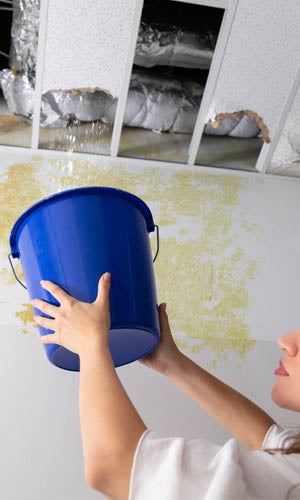Just how to Examine If Your House Has a Hidden Leakage
Just how to Examine If Your House Has a Hidden Leakage
Blog Article
In this article in the next paragraph you can find more professional tips related to Locating water leaks.

Early discovery of dripping water lines can reduce a potential disaster. Besides saving you money, it will decrease the stress as well as disappointment. The moment you locate a leakage, calling your plumber for repair work is the most effective remedy. Some tiny water leakages may not be noticeable. If you can not discover it with your naked eyes, below are some hacks that help.
1. Analyze the Water Meter
Every residence has a water meter. Inspecting it is a proven way that helps you uncover leaks. For beginners, switch off all the water sources. Make certain no one will certainly flush, utilize the tap, shower, run the washing maker or dishwasher. From there, go to the meter as well as watch if it will certainly change. Considering that no one is using it, there must be no movements. That suggests a fast-moving leakage if it relocates. Also, if you identify no changes, wait an hour or 2 and inspect back once more. This suggests you may have a sluggish leakage that can also be below ground.
2. Check Water Intake
Assess your water bills as well as track your water usage. As the one paying it, you must see if there are any kind of discrepancies. If you find sudden changes, in spite of your usage being the same, it indicates that you have leakages in your plumbing system. Bear in mind, your water costs ought to fall under the exact same variety monthly. An abrupt spike in your bill indicates a fast-moving leak.
Meanwhile, a stable increase every month, even with the same habits, reveals you have a slow-moving leakage that's likewise slowly rising. Call a plumber to extensively inspect your residential property, particularly if you feel a cozy area on your flooring with piping beneath.
3. Do a Food Coloring Test
When it comes to water usage, 30% comes from toilets. If the shade somehow infiltrates your dish during that time without flushing, there's a leakage between the tank as well as bowl.
4. Asses Outside Lines
Don't neglect to check your exterior water lines too. Examination faucets by attaching a yard tube. Needs to water leak out of the link, you have a loosened rubber gasket. Replace this and also ensure all connections are tight. If you've got a lawn sprinkler, it will certainly aid get it properly analyzed and also kept annually. One small leakage can squander lots of water and surge your water costs.
5. Check and also Analyze the Circumstance
Home owners should make it a routine to examine under the sink counters and also inside closets for any kind of bad odor or mold growth. These two red flags suggest a leakage so punctual focus is required. Doing routine evaluations, even bi-annually, can save you from a significant issue.
Examine for stainings as well as deteriorating as many pipes and appliances have a life span. If you suspect dripping water lines in your plumbing system, do not wait for it to escalate.
Early detection of dripping water lines can reduce a potential calamity. Some little water leaks might not be visible. Examining it is a guaranteed method that helps you uncover leaks. One little leakage can squander tons of water and also spike your water costs.
If you presume leaking water lines in your plumbing system, do not wait for it to intensify.
How to Know If Your Home Has a Hidden Leak
Water Meter Reveals Inexplicable Water Usage
If you’d like to test whether or not there’s a leak somewhere in your home, you can do this using your water meter. Here is how to conduct the test:
Don’t use any water in your home for at least 30 minutes; this also means not turning on faucets or water-using appliances.
Go outside, and check your water meter for activity.
If your water meter shows that there was activity, even though no one was using any water, this proves that there is a leak in your home.Visible Mold or Mildew Growth
Leaks behind walls create moist, dark environments that allow mold and mildew to grow and thrive. Eventually, you might see mold growth forming on the wall closest to a hidden leak.
If mold is growing in an area that receives a high amount of moisture, such as a bathroom, it may simply be an indication that better ventilation is needed. However, if you see mold growth on a wall or the ceiling in an area where you would not expect, you probably have a hidden leak.
Musty, Mildew Odor
Sometimes you might not be able to see the mold or mildew that is growing as a result of a leak. However, the smell can give the problem away just as easily. If you catch a whiff of something musty, there’s a good chance that old water is collecting somewhere in your home that you can’t see.
Stained/Warped Walls, Ceilings, or Floors
When your home soaks up water, a variety of red flags can become visible, including ceiling stains, bubbling drywall, warped walls, and sagging floors. While these issues can be caused by excess humidity, they can also be signs that a pipe or plumbing connection has started leaking behind your walls.
Inexplicably High Water Bill
After a while, you get a general sense for what your water bill should be. If you own a pool or sprinkler system, your bill will tend to be higher during summer. However, if you receive a water bill that seems especially high, and you can’t figure out what caused it, then you may have a hidden leak somewhere that’s increasing your bill.
https://www.plumbingjoint.com/blog/2019/july/how-to-know-if-your-home-has-a-hidden-leak/

Hopefully you liked our excerpt about Leaking water lines. Thank you so much for finding the time to read through our article. Sharing is caring. You never know, you may be helping someone out. Bless you for your time. Don't forget to check our blog back soon.
Report this page